
The first pirates movie in this series had Captain Jack Sparrow, Orlando Bloom's Will Turner and Keira Knightley's Elizabeth Swann battle a ghost ship. It was manned by undead phantoms whose bone-rattling evil could be unleashed only by moonlight.
Of course if you think about it, the first "Pirates of the Caribbean" (2003) might've been a hit without Depp, but it wouldn't have been much else. It turns out Johnny Depp's presence pulled in the money more than anything else.
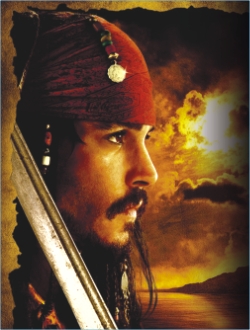 The second Pirates movie differs in the fact that this time it's all about Depp and his pirate character apparently. The others seem to play a slight side role if nothing else but heck, that's not a bad thing because almost everyone is a fan of the swaggering wavering fashion conscious pirate.
The second Pirates movie differs in the fact that this time it's all about Depp and his pirate character apparently. The others seem to play a slight side role if nothing else but heck, that's not a bad thing because almost everyone is a fan of the swaggering wavering fashion conscious pirate.
The plot:
Captain Jack Sparrow (Depp) finds himself indebted to an aquatic maniacal version of the infamous pirate Davy Jones (Bill Nighy, with squid tentacles coming out of his chin). Not only that, he (Sparrow) is on the run form the evil clutches of an ordinary evil businessman, Lord Beckett (Tom Hollander).
The verdict:
And that is pretty much the gist of the movie. It's a long drawn out chase cum thriller cum comedy. And it excels beyond expectations. "Pirates of the Caribbean: Dead Man's Chest" has less violence than the first film and twice the laughs.
Considering how sequels often turn out to be duds this is one of those few exceptions. Where the first excelled in making all the necessary introductions between cast and audience the sequels does away with the niceties and carries on with what the viewers really want. And that is the antics of the semi-drunk Sparrow. You also get to see Depp's co-stars Bloom and Knightley, but this isn't their film. Not by a long shot.
The movie is produced by action guru Jerry Bruckheimer of CSI fame which is among many credits to his name. And as a result you are guaranteed to see some action shots that have not been tried before. Takes for example the sequence where our beloved friendly pirates escape from a pair of coconut-shaped swinging cages, while Sparrow runs around like a shish kebab, having fled the scene of his own last supper on an island ruled by cannibals.
Then there is the sequence where Bloom and Jack Davenport (as ex-Commodore Norrington) duel away atop a spinning water wheel. There's a lot of slapstick humour involved here and none that involve gross bodily gags. And the kinetics of balancing and fighting and the choreography is simply amazing.
The characters are once again colourful and make a deep impression. Sparrow continues to have women swoon even though he has badly applied mascara and squiggly facial hair in the movie. If anyone else other than Depp acted drunk like that women would throw their shoes at him. It goes to show that he makes one heck of a funky pirate.
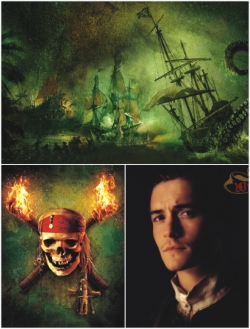 Davy Jones with a digital animatronics octopus head hammers away at a pipe organ, each tentacle on the keys add t the humour but at the same time retain a touch of evil.
Davy Jones with a digital animatronics octopus head hammers away at a pipe organ, each tentacle on the keys add t the humour but at the same time retain a touch of evil.
And let's not forget the biggest albeit computer generated set piece of the movie. Jones has in his control the sea monster known as the Kraken, an old-school mythological "beastie," as Sparrow calls it. Verbinski and company allow the full size and nastiness of this many-splendoured computer-generated nemesis to emerge onscreen in careful increments. "Dead Man's Chest" there's a lovely long shot depicting the first time the Kraken grabs hold of a ship and takes it under.
At two and half hours this movie does not seem too long at all as the action and the infectious humour carries it along smoothly till the end credits. And it couldn't have been done with so much aplomb without Depp.

By Tareq
Congratulations! You've stopped staring at the pictures and finally turned your attention to the gibberish written here. The car is the 2005 Saleen S7 Twin Turbo as the name may have suggested, and it accelerates from 0-60 mph in 2.8 seconds. The Saleen S7 has been around for quite a while. It first came out in 2002, and it blew away the competition. It was the only legal streetcar in America with more than 500 horsepower and 500 lb-ft of torque. The media and all the S7 owners were driven crazy by S7 and the car won recognition in numerous automobile magazines as the fastest American production car.
In the past three years a lot things have changed however. The automobile world has seen awesome performances from cars from manufacturers such as Ferrari, Lamborghini, Mercedes-Benz, Porsche and Chevrolet with all of them spewing out horsepower above the 500 mark. But the S7 manufacturers aren't people to sit down content on past 0-60 mph times or quarter mile speeds. Everything's changed now.
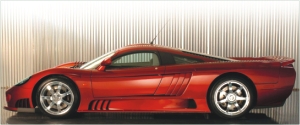 The first big change in the new S7 is its significant change in horsepower. Now it boasts 750 horsepower and 700 lb-ft of torque, numbers that'll sting the competition for a while.
The first big change in the new S7 is its significant change in horsepower. Now it boasts 750 horsepower and 700 lb-ft of torque, numbers that'll sting the competition for a while.
Aerodynamics has also come under change in 2005. Unless the original S7 is put beside the Twin Turbo the changes are unnoticeable. The Twin Turbo sports a new rear spoiler and reshaped front fenders to tweak the S7's already sweet lines. The '05 S7 has 40% reduction in aero drag and a 60% increase in down force.
The new all aluminium V8 engine casting was engineered by Saleen to displace seven liters. Space age materials and engineering has been used all through, including titanium retainers, stainless steel valves, beryllium exhaust valve seats, an aluminium throttle body, Saleen designed aluminium CNC machined cylinder heads and stainless steel exhaust systems. At this point here there was a lot of technical gibberish than no sane person could understand.
To feed juice to this setup, the injection system includes dual electric fuel pumps and high-capacity, return-less, 52 lb/hr fuel injectors. The four exhaust pipes from each bank of the cylinders merge into a racecar like high efficiency collector. At point in the article, normal people have already lost interest in the article and have taken to staring at the pictures again.
A major improvement in this ride is the use of coil springs that's a dual stage design. The first spring has a lower rate than the single springs fitted to the current S7, resulting in softer ride during normal street driving. The brakes are among the largest in any production car with 15 inch vented discs up front and 14 inch vented discs rear in the back.
All the major competition from cars such as the Ferrari Enzo, McLaren F1, Maserati MC 12, aren't a match for the 2005 Saleen S7 Twin Turbo's horsepower and torque figures. All are at least 100 bhp and more than 200 lb-ft in arrears of the S7. The Twin Turbo cost's $100,000 less than the Enzo (which is out of production and increasing in price) and 300,000 less than the Maserati. And you could have two S7's for the price of a McLaren! The price is still a lot though; this car costs around $555,000. Wonder how long it'll take me to save that much...

"Keep it simple, stupid" isn't a credo that space-sim developers have subscribed to over the years. While other games have practically beaten players senseless with the complicated economics of buying and selling futuristic space-goods, the developers of DarkStar One apparently realized that some of us just want to be Han Solo. This game "gets" the template of 1985's Commodore 64 classic Elite in a way that many other space-trading games released over the past decade or so didn't, thanks to its emphasis on the mid-'80s classic's simple principles of buying low, selling high, and blasting pirates for fun and profit. It comes with a few minor problems in the fit-and-finish department, but the game is still an outstanding return to the frontier spirit that made Elite so memorable.
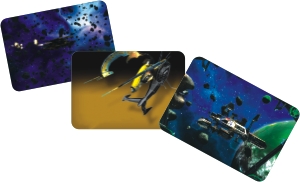 As with all space traders, the story revolves around a man of mystery with a brand-new spaceship, enigmatic aliens on the attack, and a few dozen planets producing merchandise you can haul around the galaxy to make a few bucks. This time out the man is Kayron Jarvis, the mystery to be unraveled is the identity of his father's murderer, the nasty aliens are the biomechanical Thul, and the galaxy is a few hundred star systems with suitably sci-fi names like Pachae and Cloosa.
As with all space traders, the story revolves around a man of mystery with a brand-new spaceship, enigmatic aliens on the attack, and a few dozen planets producing merchandise you can haul around the galaxy to make a few bucks. This time out the man is Kayron Jarvis, the mystery to be unraveled is the identity of his father's murderer, the nasty aliens are the biomechanical Thul, and the galaxy is a few hundred star systems with suitably sci-fi names like Pachae and Cloosa.
Gameplay options are predictable, too. You can stick close to the main story missions (which spin an interesting tale, if you can endure the after-school-special quality of the voice acting); take assignments on offer in spaceports; escort cargo vessels; follow up rumors of illegal activity in certain systems; get into side missions dealing with assassinations, hidden star systems, corporate malfeasance, and more; and schlep goods like machinery, spirits, precious metals, and superconductors from one system to another. Depending on the assignments you accept, you'll eventually become notorious in one of six career paths that range from mercenary to trader to flat-out killer.
But even though all of the above plays pretty much strictly by the book, DarkStar One feels fresh. The big reason for this is a relatively simplistic approach to everything and a user-friendly core. Missions feature a fair bit of variety, involving everything from covert listening ops to blasting an entire pirate gang to smithereens, but they never stray far from quick, action-oriented goals that keep you interested. Even the routine job of picking up an abandoned cargo container typically turns into a dogfight, as you can bet that pirates will locate the goods before you do.
A fair bit of money is on the table right from the beginning, too, so there's no boring grind involved in earning enough cash to buy upgrades for your ship. You can start outfitting Mk II laser cannons, missile launchers, an afterburner boost, an upgraded jump drive, and many more goodies after just a handful of quick missions. This lets you play the game as a gung-ho space sim, as there is enough cash on offer for pirate bounties alone to allow you to skip trading almost entirely.
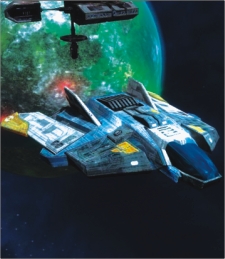 With no economic learning curve, you can dive into the game headfirst. Making big bucks in the trading game is as simple as buying crystals at the service colony of Athasho for 40 credits each and selling them at the agricultural colony of Yarie, which specializes in carbohydrates and proteins, for 90 credits each. All the essential information about each system is displayed on the galactic map screen, so you can plan lucrative, multistop trading expeditions in seconds. Devote a few hours to plying the trade routes and you can hoard tens of thousands of credits in your bank account, which is plenty of cash to really trick out the DarkStar One.
With no economic learning curve, you can dive into the game headfirst. Making big bucks in the trading game is as simple as buying crystals at the service colony of Athasho for 40 credits each and selling them at the agricultural colony of Yarie, which specializes in carbohydrates and proteins, for 90 credits each. All the essential information about each system is displayed on the galactic map screen, so you can plan lucrative, multistop trading expeditions in seconds. Devote a few hours to plying the trade routes and you can hoard tens of thousands of credits in your bank account, which is plenty of cash to really trick out the DarkStar One.
But you don't always have to add mechanical gizmos to your vessel. Unlike the ships in other space traders, the DarkStar One is a partially organic entity that can be buffed much like the run-of-the-mill fighter or cleric in an RPG. Ancient artifacts found in asteroids scattered all over the map can be absorbed and used like experience points to power your ship in various ways, like growing larger wings so that you can mount dual laser cannons. You also have an upgradable plasma weapon that boosts your ship's firepower and provides the ability to snap up a defensive shield.
Just a few headaches interfere with your career as a space rogue. Most notably, we encountered a bug that caused serious slowdowns. Everything would be fine one moment, then we would warp into a new system and immediately enter slide-show territory. Only restarting the game would get things back to the normal visuals, which are smooth-flowing with pretty, if a touch dated, asteroid-strewn space vistas dominated by gorgeous planets and shining suns. These wonderful pieces of spatial scenery sometimes come together into these postcard-like panorama scenes that can be simply breathtaking. Dated as the graphics engine sometimes looks, it's also capable of real beauty.
Unfortunately, that amazing scenery suffers due to over-repetition. As great as the game tends to look, the developers reused the same art for many of the planetary trade stations where you do your business. So you see the exact same aliens hanging out around the exact same tables in one system after another, which doesn't do much to promote the idea that you're traveling across the galaxy. Systems overall have too much of a been-there, done-that feel, as almost all of them all feature the same layout of a planet, a trade station, and an asteroid field. Audio suffers from the same problem, with a monotonous musical score and enemies who recite no more than a dozen or so canned threats and screams during dogfights.
The interface could use a little work, too. While it is easy to control the DarkStar One with a joystick or gamepad, mouse-and-keyboard movement is twitchy and there is no way to adjust mouse sensitivity. And although the in-game tutorials and gradual learning curve make it a snap to get into the game right away, some missions aren't properly explained. Sometimes you're left hanging in space without a clue what to do. Compounding the problem is how the game lets you take missions that you have no way of completing at present (for instance, when the system you need to visit is outside of the range of your current jump drive), but it doesn't provide an immediate way to drop them (you need to leave the system in question to fail a mission and clear it from your roster).
But although the flaws in DarkStar One can lead to some frustration, they never get in the way of that "just one more mission" mojo that can keep you playing the game into the wee hours of the morning. Fans of space traders shouldn't miss out on this one.
Minimum System Requirements
System: Pentium IV 1.6 GHz or equivalent
RAM: 512 MB
Video Memory: 128 MB
Hard Drive Space: 6500 MB
Other: DirectX 9.0-capable video card
Recommended System Requirements
System: Pentium IV 2.6 GHz or equivalent
RAM: 1024 MB
Video Memory: 256 MB
Hard Drive Space: 6500 MB
Other: DirectX 9.0-capable video card with 256 MB RAM
